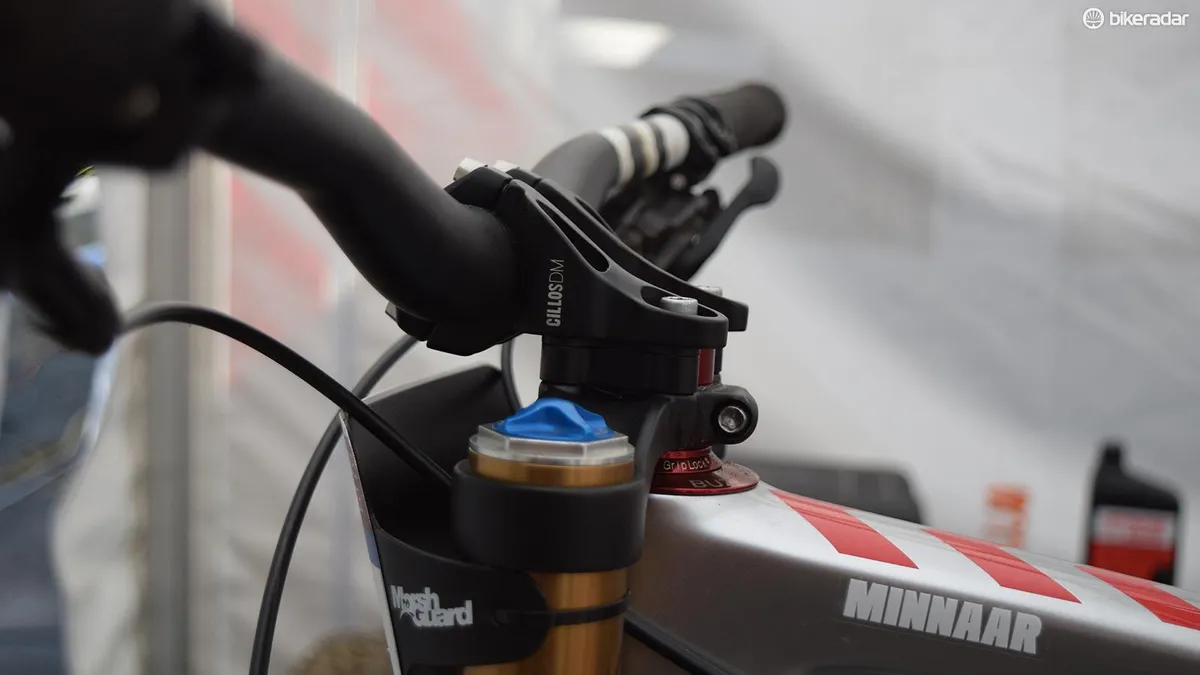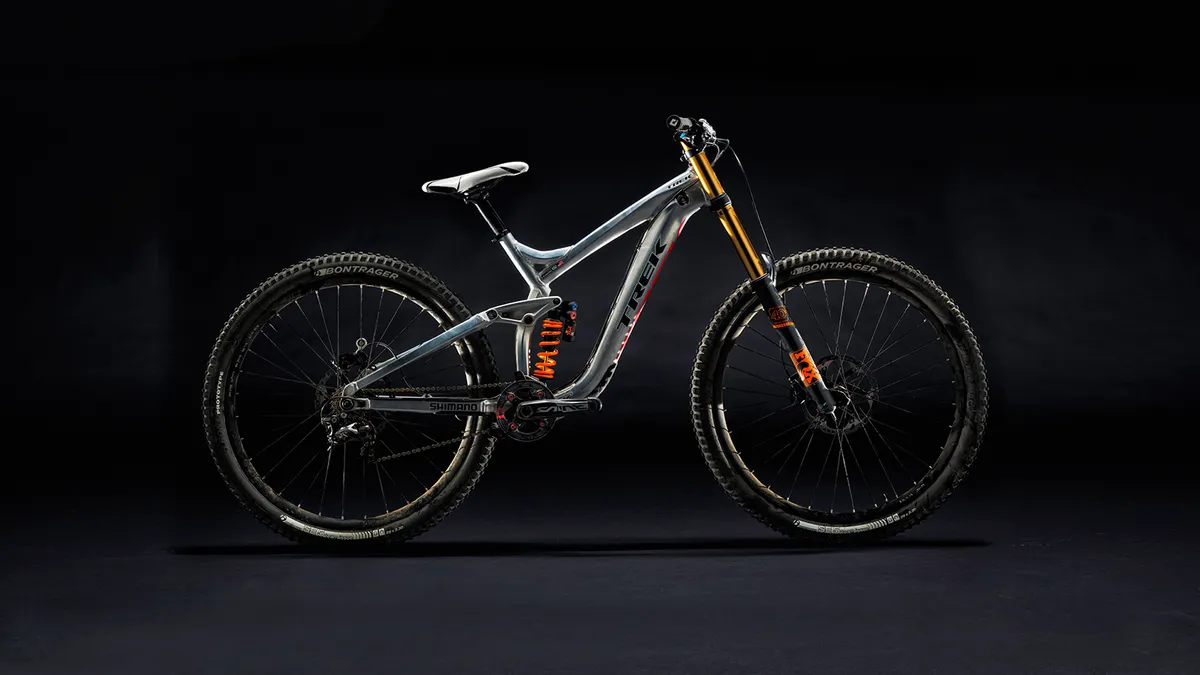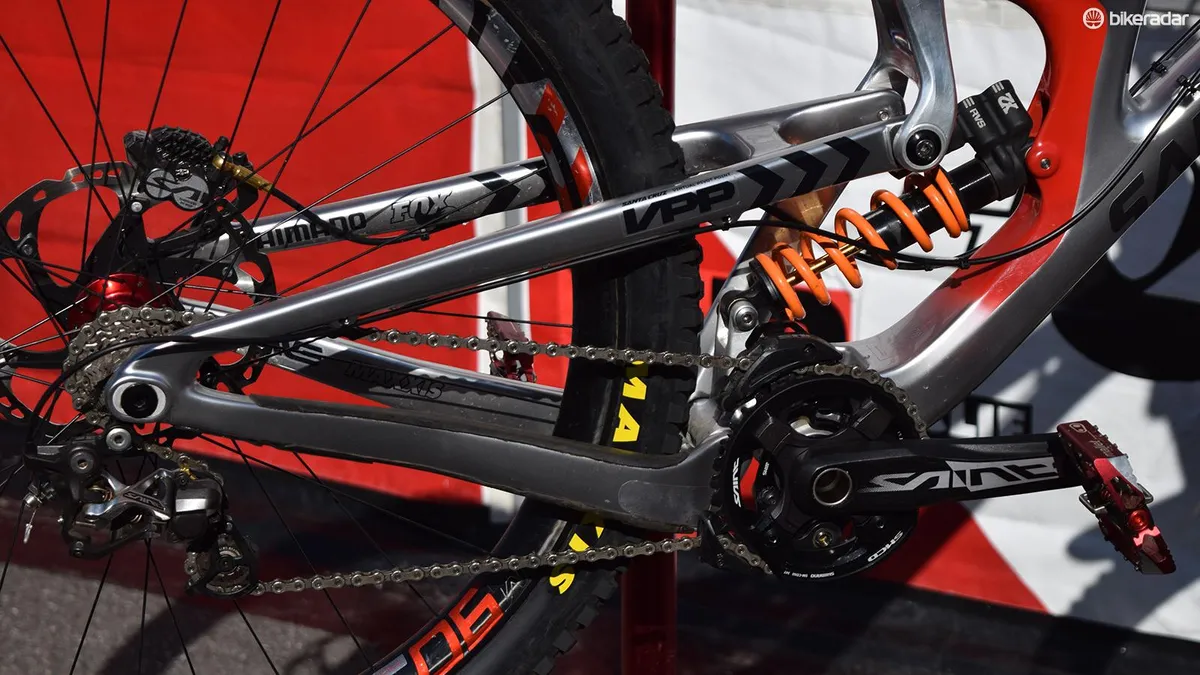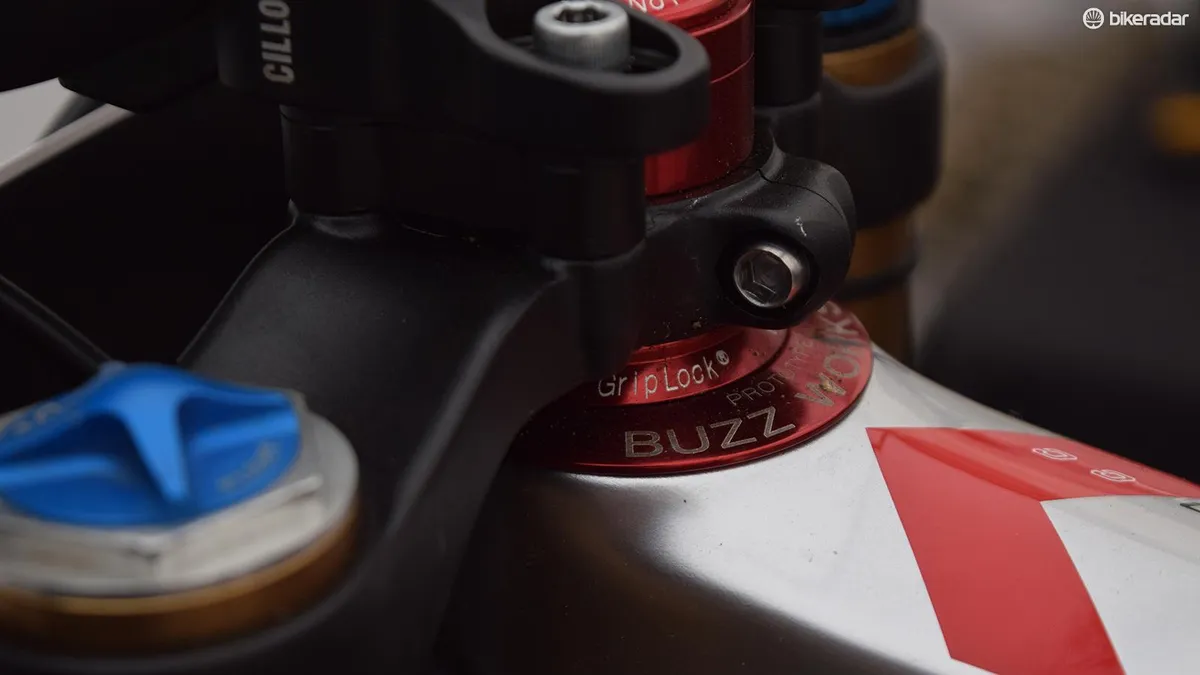When the Santa Cruz Syndicate rolled out a 29” wheeled downhill bike at the first round of the 2017 World Cup in Lourdes, it caused something of a sensation. When all three team members qualified within the top six, there could be no doubt that this bike was seriously quick.
- Tech gallery from Lourdes Downhill World Cup
- Santa Cruz flaunts 29er V10 ahead of Lourdes World Cup debut
Loris Vergier, Luca Shaw and Greg Minnaar qualified 1st, 3rd and 6th respectively on the 29er V10. When it came to the race its self, rain scuppered the Syndicate’s chances to prove their worth where it counts.
Yet despite a hair-raising run from eventual winner, Alex Fayolle, Loris Vergier’s qualifying time remained the fastest of the weekend. This show of pace will surely cause some head-scratching among the other teams.
We asked Luca Shaw to what extent he thought that success was down to the bike.
“I know I would be able to go as fast on my 27.5 bike,” Luca insists. “It really annoys me when people say I would not be able to qualify 3rd without my 29er, especially since I was achieving similar results last season. I think the 29er has a lot of potential and room for improvement still, but at the end of the day downhill racing is about the rider, not the bike. Plus Loris proved last season he had the speed to win, and Greg has proven he is the greatest his whole career so what's out of line with a strong qualifying result?”
Maybe so, it would be churlish not to applaud the achievements of the riders, but the right bike makes a big difference at this level. Racing is never the best judge of a bike’s performance, given the unpredictable and inseparable interplay between rider and machine. But the Syndicate claim their off-season testing has shown the 29er to be faster. According to Loris “I was consistently posting quicker times on the new bike compared to the old—and this was on my local track!”
So, it seems to work. But Santa Cruz was not the first to try squeezing 29” wheels in a downhill bike. Intense tried it back in 2011; KHS and Trek prototyped various big-wheeled bikes over the years, too. But none ever made it to production and none have competed at World Cup level. So how has Santa Cruz succeeded where others failed?
Cut ‘n’ shut
You might imagine the engineers had to completely redesign the V10 to accommodate those big wheels. Not exactly. The mainframe is actually a production V10 front-end – look closely, and you’ll see “27.5” printed on the downtube. The rear swingarm and linkages have been redesigned to accommodate the 29” wheels. Santa Cruz dropped the bottom-bracket relative to the axles to keep the BB height - measured from the ground - the same as the old bike. The team experimented with several aluminium swingarms before committing to carbon.

The V10’s travel has also been tweaked. Loris Vergier’s size Large and Luca Shaw’s XL frames sport just 190mm of travel to keep the bigger wheel from contacting the frame when the suspension bottoms out.
Greg’s XXL frame, on the other hand, has enough room to accommodate the full 210mm rear travel. This is provided by a slightly different linkage and leverage curve.
By dropping the BB with the new rear linkage, the front triangle is slackened out a little. But the team didn’t want the new bike to be any slacker in the head angle than the old. A prototype Chris King angleset compensates for this effect, keeping the head angle at 64 degrees.
But it’s not designed to handle exactly like the old bike. Santa Cruz explained it wanted the bike to “feel like a 29er”… “We don’t want it to handle like the 27.5 bike,” says Greg’s mechanic, Jason Marsh. “We want it to be a completely new bike; a new way of looking at things.”.
The key components
So the frame is actually a tweaked version of the stock 650b bike, but the fork was custom-made to fit 29” wheels, and is a key part of what makes this bike work. Previous 29er downhill bikes used either reduced-travel inverted forks, or regular Fox 40s with the lower arch filed down to accommodate the big wheels. Not ideal.
Fox supplied the team with a prototype 29er version of the 40, dubbed the ‘49’. With 190mm of travel, its minimum crown-to-axle is apparently only 2mm taller than the 650b version (we say ‘minimum’ as dual-crown forks can always be extended), helping keep the front-end low enough despite the higher axle.

A longer fork offset (58mm, up from the standard 52mm) reduces the trail slightly, and quickens the steering in a bid to make it handle more (though not entirely) like the 650b bike.
Meanwhile, ENVE supplied the team with 29” versions of its 35mm-wide M90 wheelset, and Maxxis made full DH-casing versions of their DHR2 and Shorty tyres to fit the bigger wheels.

Thanks to these key components, Santa Cruz didn’t have to compromise on the build - no enduro tyres; no filed-down forks or wobbly trail bike wheels.
Keeping it in proportion
The Syndicate were not keen for us to measure up the bikes for ourselves in Lourdes, but told us that Greg’s XXL V10 has a wheelbase of around 1300mm, with a chainstay of 462mm. This brings us to the main reason we’ve never seen a purposeful 29er DH bike before: the bikes simply weren’t long enough until now.
The shorter a bike’s front-centre, the more you have to lean back to keep the weight distribution balanced on steep terrain. Throw in big wheels, and the rear tyre can come into contact with one’s behind – I remember regularly buzzing my rear tyre when riding a size-too-small Specialized Enduro, despite being 6’3” tall. With a longer front-centre, the riding position is more central, meaning the rider has less chance of buzzing the rear tyre on the steepest sections.
Combining long travel and big wheels also requires a lot of rear-end real estate. Longer front ends work better with longer rear-centres to balance them out. Now that we’ve largely got over the short-chainstays gimmick (in downhill at least) there’s more room to fit a bigger wheel in there.

Finally, bikes with longer reach work better with higher stack heights. Imagine putting the bar height of a modern trail bike on a BMX, or visa-versa, and you’ll see what I mean. Going back to that Specialized Enduro of mine, I used to run a 103cm bar height with a 460mm reach; now I run a 109cm bar height with a 510mm reach. Why is this relevant? Well, now that bikes have got longer in the reach, bikes feel better with a taller bar height. That means there’s more room to fit in a long-travel fork and a big wheel, without the riders having to put up with a bar that’s higher than they would otherwise choose. The short stature of the 29” Fox 40 also helps here.
Santa Cruz wouldn’t give us a firm answer on whether the team’s bar height has changed since moving to 29” wheels, explaining that it has spent a lot of time trying to optimise the bikes with the new wheel size. Although Loris’ stem is slammed, Luca and Greg look to be running a 5mm and 10mm stem spacer respectively. All three are running riser bars, and Greg’s has 28mm of rise - no issues getting the bar height low enough for him, at least.
The future of downhill?
Although Santa Cruz was the only team racing on 29ers in Lourdes, there’s sure to be many more at the next round in Fort William. Mondraker, Trek and Commencal debuted 29er DH bikes at the British Downhill Series in Fort William last weekend, and Danny Hart won on his 29” Mondraker Summum.

One manufacturer (who must remain nameless for now) told us that its 29er downhill bike went four seconds faster over a two-minute course than its 27.5” equivalent. Using on-board telemetry borrowed from motocross, it says the 29er wasn’t just faster overall, but that it went at least as fast at every point on the course. Even in the tight corners, the 29er was never appreciably slower. The Syndicate claim their off-season testing tells a similar tale. “It’s faster everywhere!” according to Greg Minnaar.

An unfair advantage? Well, world cup downhill racing has always been about technical innovation as much as rider-heroics. RockShox has a 29” Boxxer to match fox’s ‘49’ fork, so it’s possible that most world cup riders who want to experiment with 29” wheels will soon be able to do so (if they haven’t already).
Some have suggested the UCI should step in and standardise wheel size, arguing it would level the playing field. But the same case could have been made for any technological innovation in the sport’s history - 650b wheels being one example. If 29ers prove to be slower for some riders, they won’t use them, simple as that. But we think choice can only be good for the sport.
What do you think? Are 29ers good for the progress of the sport, or an unnecessary distraction from the competition between riders? Let us know in the comments below.




